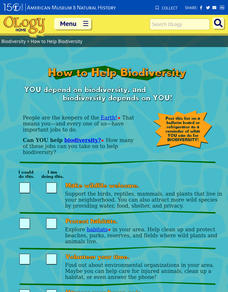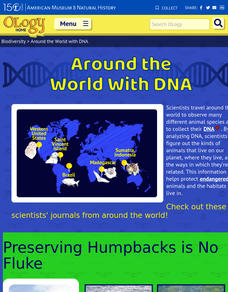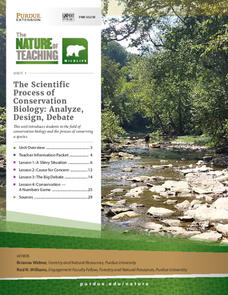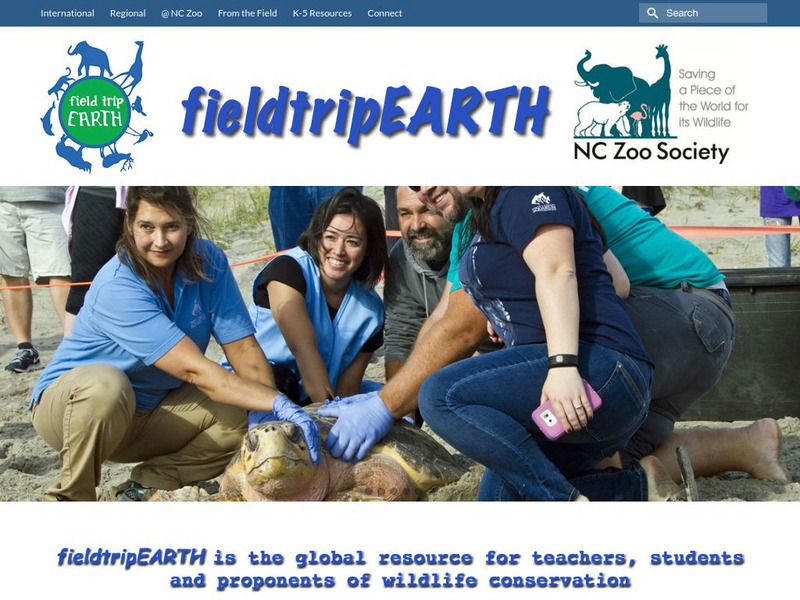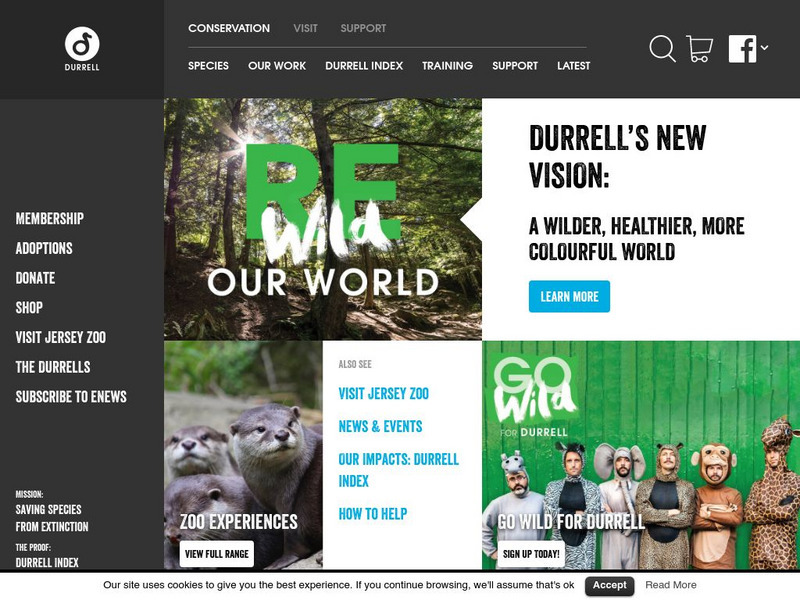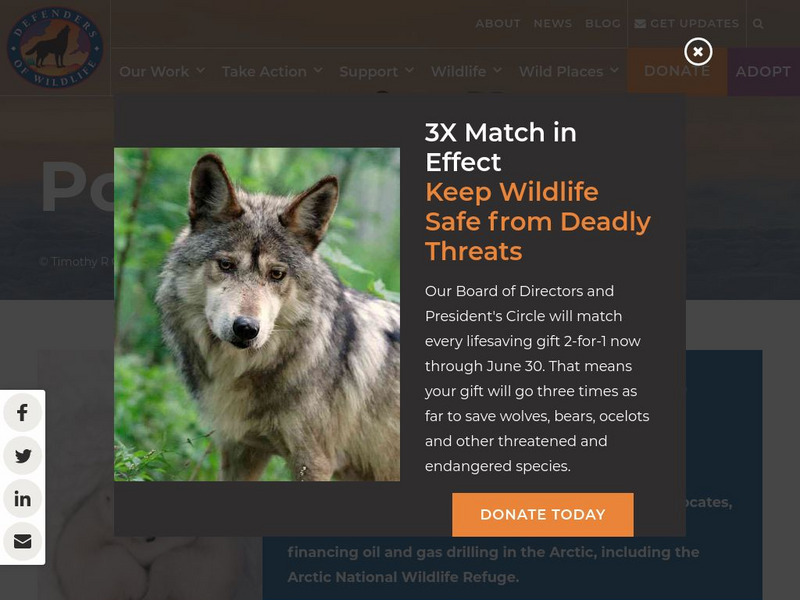British Council
A New Logo for the World Wildlife Fund
Where does the money go? Learners take a look at the logo for the World Wildlife Fund and discuss characteristics of the panda in the logo. Scholars learn that cute, fuzzy endangered animals often receive the most donations. They keep...
American Museum of Natural History
How to Help Biodiversity
A resource provides a checklist of nine actions for pupils to take to do their part in supporting biodiversity. The list suggests more obvious actions such as supporting wildlife to less obvious ideas like learning about different...
Aquarium of the Pacific
Kelp Forest Conservation
There otter be a better way. As a class, groups work together to create a food web based on the organisms in the kelp forest. Budding scientists watch a video on the kelp forest to see how the organisms create a food web and hear about...
American Museum of Natural History
Around with World with DNA
A mammalogist, ornithologist, ichthyologist, and a conservation geneticist share their work and their hopes that their research will help protect and save endangered species and their habitats.
National Wildlife Federation
Endangered Species: What and Where?
What do endangered species have in common with non-endangered species? Given an endangered species to read about, individuals choose another species that is not endangered to compare it to. As a class, they create a species book with the...
National Wildlife Federation
Prairie Chicken Pageant
Diminishing habitats is a real concern that is threatening endangered species. Learners examine these concerns by studying the prairie chicken. Groups get a card with characteristics and threats to the species that they turn into skits.
Alabama Wildlife Federation
Birds are Everywhere
Wildlife includes all animals that have not been domesticated, both big and small. Young scientists search for all types of wildlife and more importantly for evidence that wildlife is present. As they venture in an outdoor space, they...
Purdue University
Ashes to Ashes: We All Grow Up
Ecosystems are constantly changing whether people notice or not. An inquiry-based lesson examines types of ecosystem changes and how they relate to wildlife conservation. Learners classify changes as succession and disturbance using a...
Purdue University
The Scientific Process of Conservation Biology: Analyze, Design, Debate
Scientists use data to learn about species survival—and your classes can too! A set of four lessons guides learners through a process to draw conclusions about the fluctuations in the population of the Hellbender species. They read...
Purdue University
Common Indiana Mammals
Mammals all have their own story to tell. A set of 34 cards outlines the key characteristics of different mammals. The cards include images of each mammal as well as their skulls and tracks. The back of the cards describe characteristics...
Purdue University
Mammal Food Webs
You are what you eat—or at least a part of what you eat. Budding scientists examine owl pellets to develop their own food webs. They use tooth and skull identification techniques to classify what they find.
Purdue University
Animal Diversity and Tracking
What exactly are those glowing eyes in the night? Learners run an experiment to attract local wildlife and then document the number of visitors by identifying their tracks. They then analyze the data to draw conclusions about the types...
Howard Hughes Medical Institute
Lesson 2: Gorongosa National Park
How has Gorongosa National Park changed over time? Discover the park's rich history, dating back to primitive human times, through an interactive timeline and scientific reading. The second installment in an eight-part series explores...
Canadian Wildlife Federation
Hinterland Who's Who: Benefits of Wildlife
Learn about the importance of wildlife in our lives. Look at the role of wildlife in natural processes, as well as in science, agriculture, and medicine. Also, discover how wildlife factors into the Canadian economy. Finally find out how...
Other
Washington Hunter's Ed Course: Study Guide for Certification Card
This is a complete preview of a timed hunter education course. The online course requires registration (free) and, on successful completion, the user qualifies for a hunting certificate in Washington State. This comprehensive course...
Other
North Carolina Zoological Society: Field Trip Earth
Resources for students and teachers about animal conservation research programs around the world. Articles, interviews, and field reports are available.
Tramline
Tramline: Getting Green Virtual Field Trip
In this comprehensive website, students will learn about different forms of pollution, environmental impact of pollution, global warming, and things they can do to make a difference.
Other
Cincinnati Zoo and Botanical Garden
A leader in conservation and education, the Cincinnati Zoo is rated among the top zoos in the United States. Site provides information on various animals as well as conservation efforts and educational programs.
Other
Fundacion Vida Silvestre Argentina
This Spanish language page is the on-line home of the Argentinian Wildlife Foundation or the Fundacion Vida Silvestre Argentina, that presents information about biodiversity in Argentina and efforts to protect it.
Other
University of Delaware: Major Resource Kits
Major Resource Kits link academic majors to career alternatives by providing information on career paths, sample job titles, and a short bibliography of Career Resource Center materials available to students in a particular major....
Reading Is Fundamental
Reading Is Fundamental: Illustrate a Story: The Last Panda [Pdf]
Print this short story about panda bears and about the consequences of human encroachment into their diminishing habitat and then illustrate it and bind it as a book.
Smithsonian Institution
Smithsonian Libraries: Zoos, a Historical Perspective
An online sample of maps, drawings and photographs of zoos from over 30 states and 40 countries.
Other
Durrell Wildlife Conservation Trust: Jersey Zoo
Jersey Zoo is the headquarters for the Jersey Wildlife Preservation Trust near St. Helier, Channel Islands. This site contains information about the animals, the park, and the activities outside of the park.
Defenders of Wildlife
Defenders of Wildlife: Polar Bear
Has a fact sheet on the polar bear and video footage of a polar bear in the Arctic.



